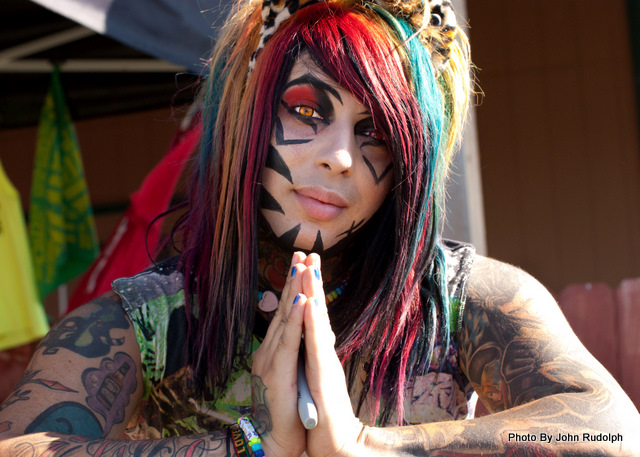The name Dahvie Vanity might not ring a bell for many, but for those who lived through the early 2000s emo scene, it evokes a mix of nostalgia, intrigue, and perhaps even unease. Vanity, the frontman of the band Blood on the Dance Floor, became a figure of fascination due to the band’s catchy, synth-heavy music and his captivating, often theatrical stage presence. However, Vanity’s life and career have been shrouded in controversy, with accusations of sexual misconduct and predatory behavior casting a dark shadow over his legacy.

Image: backbeatseattle.com
The story of Dahvie Vanity and Blood on the Dance Floor is a complex one, weaving together themes of music, fandom, and the darker side of celebrity culture. This article seeks to delve into the intricacies of Vanity’s rise and fall, exploring both the allure and the controversies that have defined his time in the spotlight.
Blood on the Dance Floor: The Early Days
A Rise from MySpace to Mainstream
Blood on the Dance Floor (BoDF) emerged in the mid-2000s, riding the wave of the burgeoning emo scene. The band’s music, a blend of electronic and metal influences, resonated with a young, often disillusioned audience, fueled by raw emotions and an almost theatrical darkness. Vanity’s on-stage persona, a mix of charisma and theatricality, further captivated fans who embraced the band’s unique aesthetic.
BoDF’s early success can be attributed to their strategic use of online platforms, particularly MySpace. Their MySpace page became a hub for fans, with Vanity actively engaging with their audience, creating a sense of intimacy and connection that was rare for bands at the time. This online presence proved invaluable in building the band’s fanbase, launching their career beyond the confines of their local scene.
Musical Style and Themes
Blood on the Dance Floor’s music was a potent mix of electronic, industrial, and metal elements. Their sound was characterized by heavy bass lines, pulsating synths, and aggressive vocals, creating a dark and pulsating atmosphere. This style, combined with their use of dark, often gothic imagery in their music videos and live performances, cemented their place within the growing sub-genre of “electronic metal.”
Their lyrics, often dealing with themes of death, horror, and the darker side of love, were both shocking and appealing to their young audience. While many bands within the emo subculture grappled with themes of heartbreak and angst, BoDF pushed the boundaries further, exploring more morbid and taboo subjects, making them stand out in a crowded scene.

Image: www.fanpop.com
Dahvie Vanity: The Controversial Figure
Allegations and Scandals
Despite their initial success, Dahvie Vanity’s reputation began to tarnish as accusations of sexual misconduct and predatory behavior began to surface. These allegations stemmed from various sources, including former fans and band members, as well as online forums and social media discussions. The accusations, including grooming, manipulation, and statutory rape, painted a dark picture of Vanity’s supposed conduct, throwing a shadow over the band’s legacy.
Vanity denied these allegations, claiming they were false and fueled by disgruntled ex-fans and vengeful former band members. However, the volume and consistency of these accusations, combined with the lack of any meaningful response or rebuttal from Vanity or the band, led many to question his side of the story. This controversy ultimately contributed to the band’s decline and eventual disbandment.
The Impact of the Allegations on the Band and Fans
The allegations against Vanity had a profound impact on the band’s fan base. Many fans, disillusioned and angered, distanced themselves from the band and Vanity, abandoning their previous support. This led to a significant decrease in fan engagement, album sales, and tour attendance, hindering the band’s ability to maintain their momentum and ultimately contributing to their downfall.
The controversy also created a deep divide within the BoDF fandom, with some fans remaining loyal to the band despite the accusations, while others actively rallied against Vanity and the band. This division, fueled by online debate and social media activism, became a major feature of the band’s later years, further complicating their image and legacy.
The Aftermath and Legacy
Despite the controversies that plagued his career, Dahvie Vanity continues to be a controversial figure in the music industry. While he has not released any new music as Blood on the Dance Floor since the band’s disbandment, he maintains a limited social media presence and remains a subject of discussion and debate within the internet community, particularly within online forums dedicated to the emo scene.
Vanity’s legacy is complex and ambiguous. While some remember him for the catchy music and theatrical energy of Blood on the Dance Floor, others view him as a symbol of the darker side of celebrity culture, tainted by serious accusations. Regardless of one’s perspective, it’s clear that the story of Dahvie Vanity and Blood on the Dance Floor is a cautionary tale about the perils of unchecked power and the fragility of fame.
Navigating the Controversy: Insights from Experts and Fans
Understanding the Complicated Legacy
The story of Dahvie Vanity and Blood on the Dance Floor highlights the complexities of navigating allegations of misconduct in the entertainment industry. It reminds us that separating the art from the artist can be a challenging task, especially when the artist’s personal life overshadows their creative work. This conflict between appreciation for the music and disgust towards the alleged actions of the artist is a challenge faced by many fans, leaving them questioning their own loyalty and the boundaries of permissible support.
Balancing Fandom and Accountability
The Dahvie Vanity case also raises important questions about the responsibilities of fans, particularly in the age of online platforms where fan communities play a crucial role in promoting and supporting artists. Fan communities often act as guardians of the artist’s image, protecting them from criticism and promoting their work. However, in cases of serious accusations of misconduct, fans are often left in a difficult position, balancing their love for the music with the need to hold the artist accountable for their actions. This delicate balance requires navigating complex ethical dilemmas, demanding critical thinking and compassionate understanding of the impact of allegations on all involved.
FAQs About Dahvie Vanity and Blood on the Dance Floor
Q: How did Blood on the Dance Floor become popular?
A: Blood on the Dance Floor’s popularity stemmed from their unique electronic-metal sound, their theatrical live performances, and their savvy use of online platforms like MySpace to connect with fans.
Q: What are the most serious allegations against Dahvie Vanity?
A: The most serious allegations against Dahvie Vanity include grooming, manipulation, and statutory rape. These accusations have been widely circulated online, though Vanity has consistently denied them.
Q: Did Blood on the Dance Floor ever respond to the accusations against Dahvie Vanity?
A: The band never issued a formal public statement directly addressing the allegations against Vanity. However, they did release a song titled “Lies Lies Lies” which many fans interpreted as a response to the accusations.
Q: What happened to Blood on the Dance Floor?
A: Blood on the Dance Floor disbanded in 2016, citing creative differences and internal conflicts. While the band’s official statement made no mention of the allegations against Dahvie Vanity, many fans believe that the controversies surrounding him played a significant role in their downfall.
Q: Is Dahvie Vanity still making music?
A: Although Dahvie Vanity has not released any new music under the Blood on the Dance Floor moniker, he has occasionally posted content on his social media pages hinting at new music projects.
Dahvie Vanity From Blood On The Dance Floor
Conclusion
The story of Dahvie Vanity and Blood on the Dance Floor is a complex tapestry woven with threads of music, controversy, and the delicate balance of fandom and accountability. While the band’s music continues to resonate with some fans, the allegations against Vanity have irrevocably stained their legacy. This story serves as a reminder of the importance of critically examining the artists we support and holding them accountable for their actions, even when it conflicts with our love for their art.
Are you interested in learning more about the impact of the Dahvie Vanity controversy on the emo music scene? Share your thoughts and opinions in the comments below!






